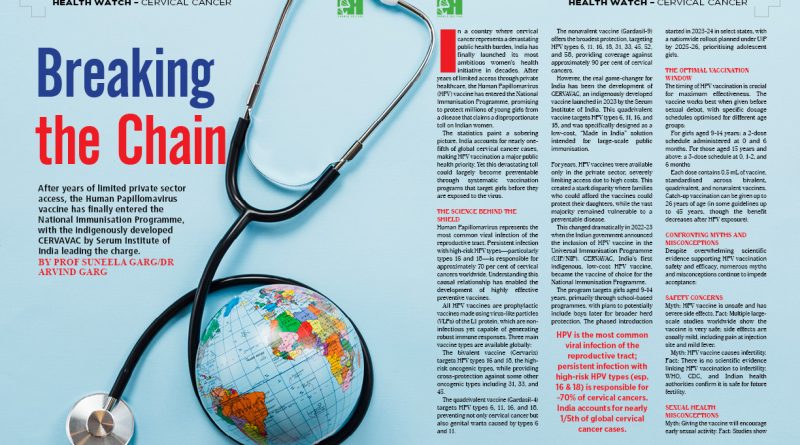Breaking the Chain
After years of limited private sector access, the Human Papillomavirus vaccine has finally entered the National Immunisation Programme, with the indigenously developed CERVAVAC by Serum Institute of India leading the charge.
By Prof Suneela Garg/Dr Arvind Garg
In a country where cervical cancer represents a devastating public health burden, India has finally launched its most ambitious women’s health initiative in decades. After years of limited access through private healthcare, the Human Papillomavirus (HPV) vaccine has entered the National Immunisation Programme, promising to protect millions of young girls from a disease that claims a disproportionate toll on Indian women.
The statistics paint a sobering picture. India accounts for nearly one-fifth of global cervical cancer cases, making HPV vaccination a major public health priority. Yet this devastating toll could largely become preventable through systematic vaccination programs that target girls before they are exposed to the virus.
The Science Behind the Shield
Human Papillomavirus represents the most common viral infection of the reproductive tract. Persistent infection with high-risk HPV types—particularly types 16 and 18—is responsible for approximately 70 per cent of cervical cancers worldwide. Understanding this causal relationship has enabled the development of highly effective preventive vaccines.
All HPV vaccines are prophylactic vaccines made using virus-like particles (VLPs) of the L1 protein, which are non-infectious yet capable of generating robust immune responses. Three main vaccine types are available globally:
The bivalent vaccine (Cervarix) targets HPV types 16 and 18, the high-risk oncogenic types, while providing cross-protection against some other oncogenic types including 31, 33, and 45.
The quadrivalent vaccine (Gardasil-4) targets HPV types 6, 11, 16, and 18, preventing not only cervical cancer but also genital warts caused by types 6 and 11.
The nonavalent vaccine (Gardasil-9) offers the broadest protection, targeting HPV types 6, 11, 16, 18, 31, 33, 45, 52, and 58, providing coverage against approximately 90 per cent of cervical cancers.
However, the real game-changer for India has been the development of CERVAVAC, an indigenously developed vaccine launched in 2023 by the Serum Institute of India. This quadrivalent vaccine targets HPV types 6, 11, 16, and 18, and was specifically designed as a low-cost, “Made in India” solution intended for large-scale public immunisation.
For years, HPV vaccines were available only in the private sector, severely limiting access due to high costs. This created a stark disparity where families who could afford the vaccines could protect their daughters, while the vast majority remained vulnerable to a preventable disease.
This changed dramatically in 2022-23 when the Indian government announced the inclusion of HPV vaccine in the Universal Immunisation Programme (UIP/NIP). CERVAVAC, India’s first indigenous, low-cost HPV vaccine, became the vaccine of choice for the National Immunisation Programme.
The program targets girls aged 9-14 years, primarily through school-based programmes, with plans to potentially include boys later for broader herd protection. The phased introduction started in 2023-24 in select states, with a nationwide rollout planned under UIP by 2025-26, prioritising adolescent girls.
The Optimal Vaccination Window
The timing of HPV vaccination is crucial for maximum effectiveness. The vaccine works best when given before sexual debut, with specific dosage schedules optimised for different age groups:
For girls aged 9-14 years: a 2-dose schedule administered at 0 and 6 months. For those aged 15 years and above: a 3-dose schedule at 0, 1-2, and 6 months
Each dose contains 0.5 mL of vaccine, standardised across bivalent, quadrivalent, and nonavalent vaccines. Catch-up vaccination can be given up to 26 years of age (in some guidelines up to 45 years, though the benefit decreases after HPV exposure).
Confronting Myths and Misconceptions
Despite overwhelming scientific evidence supporting HPV vaccination safety and efficacy, numerous myths and misconceptions continue to impede acceptance:
Safety Concerns
Myth: HPV vaccine is unsafe and has severe side effects. Fact: Multiple large-scale studies worldwide show the vaccine is very safe; side effects are usually mild, including pain at injection site and mild fever.
Myth: HPV vaccine causes infertility. Fact: There is no scientific evidence linking HPV vaccination to infertility. WHO, CDC, and Indian health authorities confirm it is safe for future fertility.
Sexual Health Misconceptions
Myth: Giving the vaccine will encourage early sexual activity. Fact: Studies show no change in sexual behaviour among vaccinated adolescents. The vaccine is purely a cancer prevention tool.
Myth: Only sexually active girls need the vaccine. Fact: Vaccine is most effective before sexual debut, ideally at 9-14 years, before HPV exposure.
Gender-Related Misconceptions
Myth: Only girls/women need the vaccine. Fact: HPV also causes cancers in men (anal, penile, throat). While girls are prioritised in India’s NIP, boys also benefit from vaccination.
Cervical Cancer Misunderstanding
Myth: Cervical cancer is hereditary, so vaccine cannot prevent it. Fact: Cervical cancer is caused mainly by HPV infection, not genetics. Vaccine prevents infection and hence cancer.
Myth: Regular Pap smears or VIA screening is enough; vaccine is not necessary. Fact: Screening helps detect disease early but does not prevent HPV infection. Vaccination plus screening together give maximum protection.
Cultural & Social Misconceptions
Myth: HPV vaccine is not needed for unmarried girls. Fact: Vaccine is recommended irrespective of marital status; it works best if given before sexual exposure.
Myth: Traditional practices (ayurvedic/herbal remedies) can prevent HPV. Fact: No alternative medicine has been proven to prevent HPV infection or cervical cancer.
Programmatic Misconceptions
Myth: HPV vaccine is experimental or not approved in India. Fact: HPV vaccines are WHO prequalified, licensed in India, and now part of the National Immunisation Programme.
Myth: HPV vaccine must be given every year. Fact: Only 2 doses (9-14 years) or 3 doses (15+ years) are needed for long-lasting protection.
Community Engagement: The Foundation of Success
The ultimate success of India’s HPV vaccination program depends on community engagement and social mobilisation. Addressing myths and stigma around HPV vaccine and screening requires sustained information, education, and communication campaigns using peer educators and mass media for awareness.
Involving men and community leaders increases acceptance of vaccination and screening programs. When fathers, community leaders, and influential figures understand and support HPV prevention, family acceptance increases dramatically. These community partnerships transform HPV vaccination from a medical intervention into a community-owned initiative supported by trusted local voices.
A Historic Opportunity for Elimination
India’s HPV vaccination program represents more than just another vaccine rollout—it symbolises the country’s commitment to eliminating preventable diseases and achieving health equity. The program is expected to drastically reduce cervical cancer incidence in India in the coming decades, aligning with the WHO Global Strategy to eliminate cervical cancer as a public health problem by 2030.
Success requires sustained political commitment, adequate financing, robust implementation systems, and most importantly, community acceptance and participation. The early experiences in pioneer states provide valuable lessons for nationwide expansion, while ongoing monitoring and evaluation will ensure programs adapt to local contexts and emerging challenges. With vaccination targeting girls aged 9-14 years primarily through school-based programmes, the foundation is being laid for a generation of women protected from a preventable cancer.
(The authors are Chair, Programme Advisory Committee, National Institute of Health & Family Welfare (NIHFW); Director, Child Care Clinic, Noida; and Head, Paediatrics, Apollo Hospital, Noida.)

